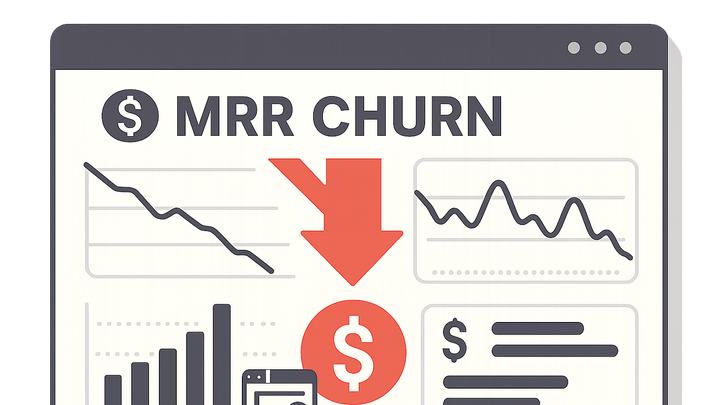Published on 2025-06-27T22:51:48Z
What is Gross MRR Churn? Examples for Gross MRR Churn
Gross MRR Churn refers to the total dollar amount of monthly recurring revenue lost due to subscription cancellations and downgrades within a specific timeframe. Unlike net MRR churn, it does not offset losses with any expansion revenue from upgrades or add-ons. This metric highlights pure revenue leakage, offering insights into the health of your subscription base. Monitoring gross churn is essential for accurate revenue forecasting and identifying areas where customer retention efforts should be focused. SaaS companies use it to spot service issues, gauge customer satisfaction, and measure the impact of product changes. By comparing gross MRR churn with related metrics like expansion MRR and net MRR churn, businesses gain a holistic view of revenue dynamics.
Gross mrr churn
Gross MRR Churn measures the total monthly recurring revenue lost to cancellations and downgrades, crucial for SaaS growth analysis.
Why Gross MRR Churn Matters
This section explains the importance of tracking pure revenue losses in your subscription business and how it impacts growth and forecasting.
-
Understanding revenue leakage
Gross MRR churn uncovers the total subscription revenue your business loses to customer cancellations and plan downgrades, without considering expansion revenue.
-
Impact on growth forecasting
By quantifying pure churn, you can build more accurate revenue projections and identify when retention initiatives are needed to sustain growth.
How to Calculate Gross MRR Churn
A clear formula and breakdown of components help you measure churn precisely and benchmark performance over time.
-
Gross mrr churn formula
Calculate gross MRR churn by summing all lost MRR from cancellations and downgrades during the period. For a churn rate, divide that sum by the MRR at the start of the period and multiply by 100%.
-
Mrr lost to cancellations
Total monthly revenue from customers who fully cancelled their subscriptions.
-
Mrr lost to downgrades
Revenue difference when existing customers move to lower-priced plans.
-
Tracking Gross MRR Churn with Analytics Tools
Implement event tracking in your analytics platform to capture cancellations and downgrades, enabling automated churn calculations.
-
PlainSignal (cookie-free analytics)
PlainSignal allows privacy-focused event tracking without cookies. Embed its script and send custom churn events to record lost MRR.
-
Setup tracking code
Embed the following in your site’s <head>:
<link rel="preconnect" href="//eu.plainsignal.com/" crossorigin /> <script defer data-do="yourwebsitedomain.com" data-id="0GQV1xmtzQQ" data-api="//eu.plainsignal.com" src="//cdn.plainsignal.com/plainsignal-min.js"></script> -
Send churn event
Trigger an event when a subscription is cancelled or downgraded:
plainSignal.track('Subscription Cancelled', { plan: 'Pro', mrr_value: 50 });
-
-
Google analytics 4 (GA4)
GA4 supports custom event tracking for subscription cancellations and downgrades, which you can then analyze in reports or export to BigQuery.
-
Setup GA4
Add the GA4 gtag script to your site:
<script async src="https://www.googletagmanager.com/gtag/js?id=G-XXXXXXX"></script> <script> window.dataLayer = window.dataLayer || []; function gtag(){dataLayer.push(arguments);} gtag('js', new Date()); gtag('config', 'G-XXXXXXX'); </script> -
Track churn event
Record a cancellation event with associated MRR value:
gtag('event', 'subscription_cancelled', { currency: 'USD', value: 50 });
-
Strategies to Reduce Gross MRR Churn
Minimizing churn requires targeted tactics across onboarding, customer success, and product experience to retain revenue.
-
Enhance onboarding experience
A strong onboarding process ensures customers quickly realize value and are less likely to cancel.
-
Interactive tutorials
Guided walkthroughs that demonstrate core features in real use-cases.
-
Onboarding email series
Automated emails that educate users and highlight best practices over the first weeks.
-
-
Proactive customer engagement
Identify at-risk accounts early and reach out to address concerns before they churn.
-
Health score monitoring
Track usage metrics and product engagement to spot customers who may churn.
-
Personalized outreach
Use email, in-app messages, or calls to resolve issues and reinforce value.
-
-
Flexible pricing and upsell paths
Offer options that allow customers to downgrade or add-on services rather than fully canceling.
-
Pause subscription
Let customers temporarily halt billing during low-usage periods instead of cancelling.
-
Custom add-ons
Provide a-la-carte features that boost value and prevent downgrades.
-
